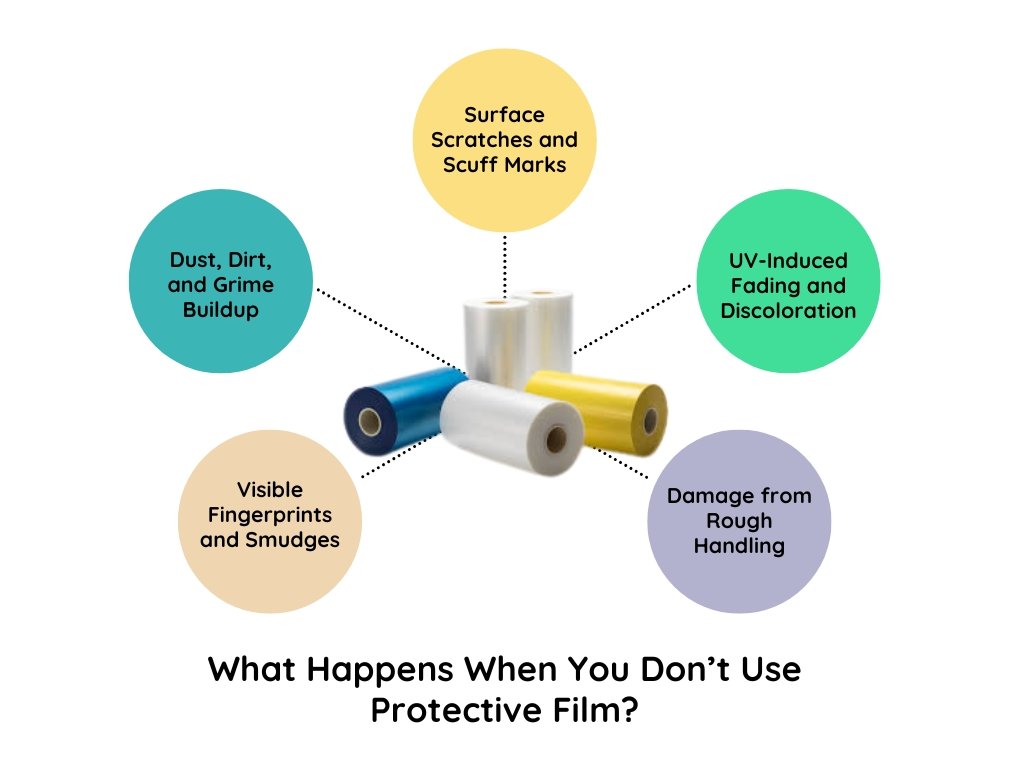There’s a quiet moment after every product is made—a moment full of hope. I hope that it reaches its final destination just as it left the factory: perfect. But the journey from the factory to the customer is full of risks like scratches, dust, dents, and rough handling. That’s where protective films step in for surface damage prevention. They don’t just cover surfaces—they protect the hard work that went into creating them.
What Are Protective Films?
Protective films are thin layers of plastic or polymer material. They stick to surfaces temporarily to shield them from damage. These films come with low-tack adhesives that are easy to remove without leaving any residue.

They are widely used across industries like:
- Electronics
- Automotive
- Construction
- Appliances
- Packaging
Whether it’s a glossy panel, a polished metal sheet, or a sensitive glass screen—protective films are like invisible shields guarding surfaces against damage.
Why Post-Production Damage Happens?
Before a product reaches the customer, it goes through many phases—assembly, packaging, storage, transport, unpacking, and installation. Each step adds a risk:
- When someone is touching delicate surfaces
- Dust settling on products in storage and transportation
- Vibrations and collisions during transport
- Accidental scratches during installation
Even a small scratch or scuff can lead to product rejection, rework, or replacement—costing time, money, and reputation.
How Protective Films Prevent These Damages?
1. Protection from Scratches and Scuffs
Protective films act as a barrier between the product and any rough surface or sharp object. They absorb scratches, keeping the actual surface clean and damage-free.
2. Dust and Dirt Resistance
Products often stay in storage before being packed or shipped. During this time, dust and dirt can settle. Protective films seal the surface, preventing buildup and keeping the item looking fresh and new.
3. Safe Handling and Assembly
During assembly or installation, multiple people handle the product. Their tools, clothes, or even nails can damage it. Films allow safe, stress-free handling without fear of permanent marks.
4. UV and Chemical Protection
Some films are made with UV-resistant materials. They protect sensitive surfaces (like coated metals or screens) from yellowing or fading. Others block moisture or chemical exposure.
5. Reduced Return Rates
Damaged products lead to unhappy customers and product returns. By using surface protection, companies can deliver scratch-free items, increasing customer satisfaction and cutting down reverse logistics costs.

The Cost of Ignoring Surface Protection
According to industry data, nearly 12–15% of total product rejections in manufacturing happen due to surface damage. Reworking a product can cost 2x to 4x more than protecting it upfront.
Moreover, visible damage—even minor—lowers brand value and customer trust. Imagine receiving a new fridge with a scratch on the door. It doesn’t matter if it works perfectly—the first impression is ruined.
Sustainable Options Are Now Available
Modern protective films are now available in eco-friendly and recyclable options. Some manufacturers have started offering reusable films as well, helping reduce waste and support green production.
This makes it easier to choose protection without harming the planet.
Easy Application and Removal
One of the biggest advantages of protective films is their simplicity. They are:
- Easy to apply manually or with machines
- Designed to peel off without leaving glue marks
- Suitable for flat, curved, or textured surfaces
No special training is needed to apply them, and removal takes just a few seconds.
Conclusion
Every product carries the effort of design, precision of manufacturing, and pride of quality. To let it reach its destination safely is not just a step in logistics—it’s a form of respect for the craft.
Protective films may look simple, but they play a big role in reducing losses, protecting brand image, and ensuring customer happiness. When used wisely, they help save money, avoid product returns, and maintain perfection from start to finish.
So the next time you think about product quality—don’t just think about what goes into making it. Think about what protects it after it’s made.
